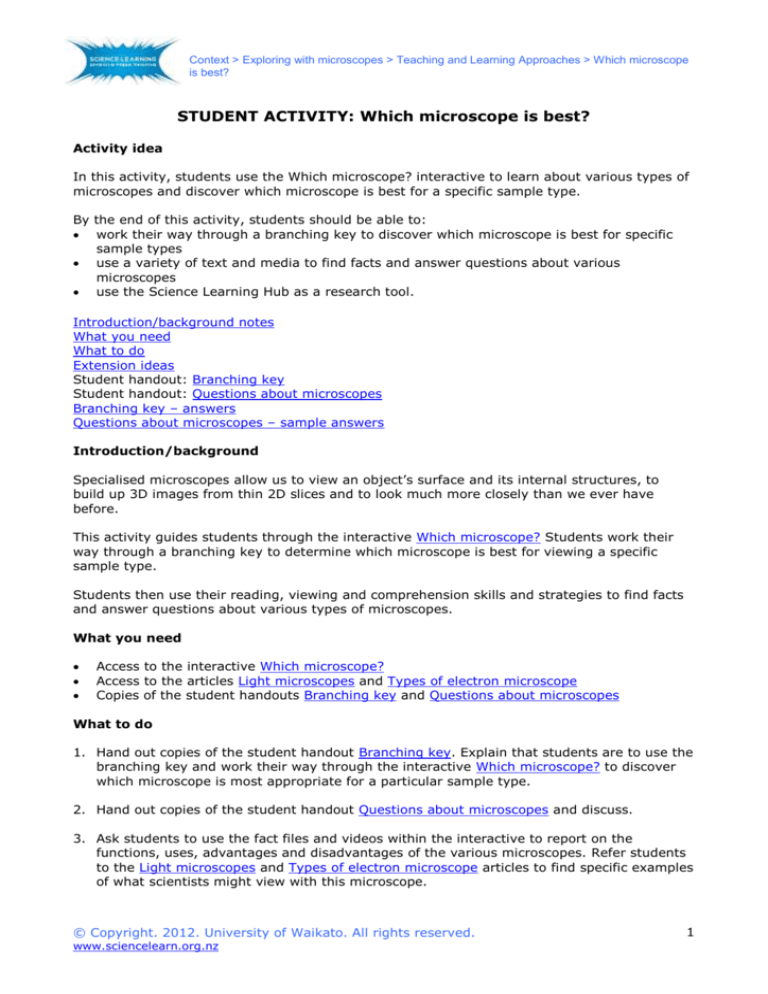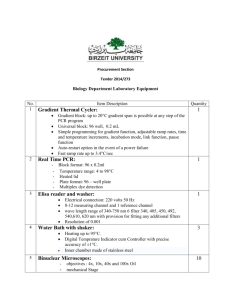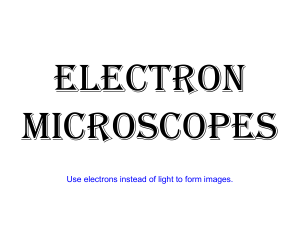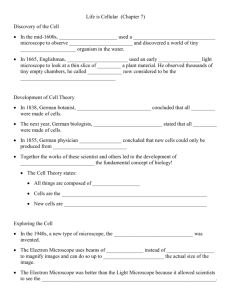
Context > Exploring with microscopes > Teaching and Learning Approaches > Which microscope
is best?
STUDENT ACTIVITY: Which microscope is best?
Activity idea
In this activity, students use the Which microscope? interactive to learn about various types of
microscopes and discover which microscope is best for a specific sample type.
By the end of this activity, students should be able to:
work their way through a branching key to discover which microscope is best for specific
sample types
use a variety of text and media to find facts and answer questions about various
microscopes
use the Science Learning Hub as a research tool.
Introduction/background notes
What you need
What to do
Extension ideas
Student handout: Branching key
Student handout: Questions about microscopes
Branching key – answers
Questions about microscopes – sample answers
Introduction/background
Specialised microscopes allow us to view an object’s surface and its internal structures, to
build up 3D images from thin 2D slices and to look much more closely than we ever have
before.
This activity guides students through the interactive Which microscope? Students work their
way through a branching key to determine which microscope is best for viewing a specific
sample type.
Students then use their reading, viewing and comprehension skills and strategies to find facts
and answer questions about various types of microscopes.
What you need
Access to the interactive Which microscope?
Access to the articles Light microscopes and Types of electron microscope
Copies of the student handouts Branching key and Questions about microscopes
What to do
1. Hand out copies of the student handout Branching key. Explain that students are to use the
branching key and work their way through the interactive Which microscope? to discover
which microscope is most appropriate for a particular sample type.
2. Hand out copies of the student handout Questions about microscopes and discuss.
3. Ask students to use the fact files and videos within the interactive to report on the
functions, uses, advantages and disadvantages of the various microscopes. Refer students
to the Light microscopes and Types of electron microscope articles to find specific examples
of what scientists might view with this microscope.
© Copyright. 2012. University of Waikato. All rights reserved.
www.sciencelearn.org.nz
1
Context > Exploring with microscopes > Teaching and Learning Approaches > Which microscope
is best?
Extension ideas
The Science Learning Hub contains many images and videos that involve a variety of
microscopes. Give students a 5-minute challenge to discover how many different types of
microscopes are featured in Hub images and/or videos.
Explain to students that they do not need to download/view the videos. They can skim through
the transcript found under each video clip. (Answers include electron, SEM, TEM, atomic force,
confocal, microCT scanner, dissection, optical, scanning tunnelling microscopes.)
Now that students are microscopy experts, they might like to try the Meet the microscopes
interactive in the Nanoscience context.
© Copyright. 2012. University of Waikato. All rights reserved.
www.sciencelearn.org.nz
2
Context > Exploring with microscopes > Teaching and Learning Approaches > Which microscope is best?
Student handout: Branching key
Use the Which microscope? interactive to complete this key. Write the type of microscope to use in the boxes.
© Copyright. 2012. University of Waikato. All rights reserved.
www.sciencelearn.org.nz
1
Context > Exploring with microscopes > Teaching and Learning Approaches > Which microscope is best?
Student handout: Questions about microscopes
Use the Which microscope? interactive and Looking Closer articles Light microscopes and Types of electron microscope to complete this table.
Microscope type Function
Stereomicroscope
(light)
Disadvantage
Useful for looking at Watch the videos to answer these questions
When does resolution start to run out when using a
light microscope?
Compound
microscope (light)
The compound microscope shines light through what
part of the sample?
Confocal laser
scanning
microscope
What example does Rebecca Campbell use to explain
how the confocal technique works?
Scanning electron
microscope (SEM)
When using a SEM, what gets knocked off the surface
of the sample and then picked up by a detector?
CryoSEM
What substance is used to prepare samples for the
cryoSEM microscope?
Electron
tomography
Does electron tomography use thinner or thicker
sections than normal electron microscopy?
Transmission
electron
microscope (TEM)
What is the TEM’s main advantage?
© Copyright. 2012. University of Waikato. All rights reserved.
www.sciencelearn.org.nz
2
Context > Exploring with microscopes > Teaching and Learning Approaches > Which microscope is best?
Branching key – answers
© Copyright. 2012. University of Waikato. All rights reserved.
www.sciencelearn.org.nz
3
Context > Exploring with microscopes > Teaching and Learning Approaches > Which microscope is best?
Questions about microscopes – sample answers
Microscope type Function
Stereomicroscope Uses light to illuminate
(light)
the surface of a
sample.
Compound
Uses visible light to
microscope (light) illuminate a thin
section of sample.
Confocal laser
scanning
microscope
Disadvantage
Usually lower
resolution than the
compound light
microscope.
Low resolution
compared to electron
microscope.
Thin cross-sections of
a living thing.
The compound microscope shines light through what
part of the sample?
Slice
Lets you look at thin
slices in a sample
while keeping sample
intact; look at parts of
a cell.
Scanning electron Lets you look at the
microscope (SEM) surface of objects at
high resolution.
Movement of
What example does Rebecca Campbell use to explain
mitochondria around
how the confocal technique works?
cells, mitosis, primary Pancakes
cilia.
And generating 3D
images of lice, flies,
snowflakes.
When using a SEM, what gets knocked off the surface
of the sample and then picked up by a detector?
Electrons
CryoSEM
Things that contain
moisture such as
plants or food.
What substance is used to prepare samples for the
cryoSEM microscope?
Liquid nitrogen
3D view of a cell or
tissue.
Does electron tomography use thinner or thicker
sections than normal electron microscopy?
Thicker
How components
inside a cell
(organelles) are
structured.
What is the TEM’s main advantage?
High resolution
Electron
tomography
Transmission
electron
microscope (TEM)
Low resolution
compared to SEM; see
only fluorescent
objects; can cause
artefacts.
Resolution not as high
as TEM; can’t use
living things – need to
dry and coat with
metal; costly.
Lets you look at the
Resolution not as high
surface of objects that as TEM; can’t use
contain liquid (easier living things – need to
sample prep).
freeze sample; costly.
Lets you build up a 3D Can’t be used with
model from a sample living samples –
from TEM data.
extensive prep
required; costly.
Lets you look at a very Can’t be used with
thin cross-section of
living samples –
an object.
extensive prep
required; costly.
Useful for looking at Watch the videos to answer these questions
A living thing like an
When does resolution start to run out when using a
insect or earthworm.
light microscope?
2000x magnification
© Copyright. 2012. University of Waikato. All rights reserved.
www.sciencelearn.org.nz
4









